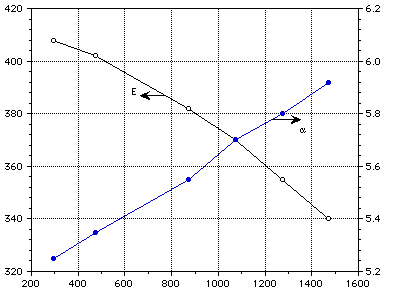 (1)
(1)Although tungsten has useful properties for a plasma facing material its disadvantages are its high-Z, low ductility, high activation, afterheat and chemical reactivity with air at high temperatures.
GENERAL PROPERTIES - TUNGSTEN [1]
Physical properties
Boiling Point : 5660 C
Density @ 20 C : 19.3 g/cm3
Melting Point : 3410 C
Electrical properties
Electrical Resistivity @ 20 C : 5.4 u [[Omega]] cm
Cold junction @0 C,
Hot junction @ 100 C : +1.12 mV
Temperature Coefficient @0 - 100 C : 0.0048 K-1
Superconductivity Critical Temperature : 0.0154 K
Thermal properties
Latent Heat of Evaporation : 4009 J/g
Latent Heat of Fusion : 192 J/g
Linear Expansion Coefficient
@ 0 - 100 C : 4.5x10-6 m/m-K
Specific Heat @ 25 C : 133 J/kg-K
Thermal Conductivity, @ 0 - 100 C : 173 W/m-K
Mechanical properties
Material Condition Soft Hard Polycrystaline
Bulk Modulus (GPa) 311
Hardness-Vickers 360 500
Poisson's Ratio 0.28
Tensile Strength (MPa) 550-620 1920
[[sigma]]y (MPa) 550
E (GPa) 411
DATA AND CORRELATIONS
The data for the thermal and structural properties of tungsten are presented in Table 1 and are taken from refs [2, 3, 4]. Polynomial correlations of the thermal and structural properties as functions of temperature in degrees K, using the data of Table 1, are as follows:
 (1)
(1)
 (2)
(2)
 (3)
(3)
 (4)
(4)
Equations (1) to (4) are valid in the temperature range of 293-2500 K.
Table 1 Thermal and structural properties of TUNGSTEN
T K [[rho]] E GPa [[nu]] k W/m-K C J/kg-K [[sigma]] [[alpha]]
kg/m3 --- y MPa (10-6)
m/m-K
293 19300.0 408.00 0.280 174.91 132.33 5.250
300 407.80 0.280 174.00 132.00 5.248
400 404.66 0.280 159.00 137.00 5.305
473 402.00 0.280 150.12 138.44 5.350
600 396.61 0.280 137.00 142.00 5.419
800 386.42 0.280 125.00 145.00 5.533
873 382.00 0.290 121.60 146.67 5.550
1000 374.36 0.290 118.00 148.00 5.646
1073 370.00 0.290 115.33 149.68 5.760
1200 360.69 0.290 113.00 152.00 5.700
1273 355.00 0.290 111.43 152.74 5.800
1473 340.00 0.290 108.39 156.17 5.920
1500 337.74 0.290 107.00 157.00 5.931
2000 295.17 0.230 100.00 167.00 6.215
2500 250.77 0.290 95.00 176.00 6.500
k (W/m-K) c (J/kg-K)

Temperature (K)
Figure 1 : Thermal conductivity and specific heat of tungsten.
E (GPa) [[alpha]] (10-6 m/m-K)

Temperature (K)
Figure 2 : The elastic modulus and thermal expansion coefficient of tungsten.